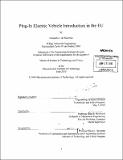Plug-in electric vehicle introduction in the EU
Author(s)
Sisternes, Fernando J. de $q (Fernando José Sisternes Jiménez)
DownloadFull printable version (11.20Mb)
Alternative title
PEV introduction in the European Union
Other Contributors
Massachusetts Institute of Technology. Technology and Policy Program.
Advisor
John B. Heywood.
Terms of use
Metadata
Show full item recordAbstract
Plug-in electric vehicles (PEVs) could significantly reduce gasoline consumption and greenhouse gas (GHG) emissions in the EU's transport sector. However, PEV well-towheel (WTW) emissions depend on improvements in vehicle technology and on the emissions produced in generating the electricity to charge the vehicle. This electricity is produced to a certain extent by conventional GHG emitting technologies such as coal, petroleum and gas depending on each country's electricity generation mix. Hence, individual country assessments need to be done to evaluate the potential gains from PEVs. This research quantifies the reductions in GHG emissions and gasoline consumption achievable by plug-in hybrid electric vehicles (PHEVs) and battery electric vehicles (PEVs) in several EU member states, focusing on two timeframes: present time and year 2035. It also outlines (1) the potential impacts that widespread PEV adoption can have on the electricity infrastructure, (2) how the PEV electricity retailing activity should be regulated to prevent utilities exercise market power, and (3) how to ensure interoperability among PEVs. Finally, this work presents projections on the incremental costs of PEVs and fuel costs savings in the EU from using PEVs. Based on the findings in this analysis, several conclusions can be drawn. First, GHG emissions assessments should consider average electricity emissions instead of marginal emissions. Second, PEVs can consistently reduce gasoline consumption but they will only reduce GHG emissions in countries with a less carbon intensive electricity generation portfolio (unlike Poland). Third, the impacts of PEV fleets on the electricity system can only be evaluated on a case-by-case basis, transformers in the distribution network being the most likely element to be affected. Four, although in EU countries fuel cost savings over the driven lifetime of a PEV are significant, upfront costs of PEVs are higher than those of mainstream technologies. Government-supported pilot projects and tax incentives can help lower cost of ownership and build the market to ultimately lower manufacturing costs.
Description
Thesis (S.M. in Technology and Policy)--Massachusetts Institute of Technology, Engineering Systems Division, 2010. Cataloged from PDF version of thesis. Includes bibliographical references (p. 84-88).
Date issued
2010Department
Massachusetts Institute of Technology. Engineering Systems DivisionPublisher
Massachusetts Institute of Technology
Keywords
Engineering Systems Division., Technology and Policy Program.